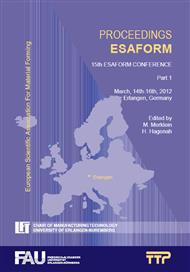p.1335
p.1341
p.1347
p.1353
p.1359
p.1365
p.1371
p.1377
p.1383
Effect of Convex Sheared Punch Geometry on Cutting Force of Ultra-High-Strength Steel
Abstract:
Extremely high strength of the ultra-high-strength steels leads to increased load factors on the tooling machines and punching tools. This experimental study examines how much convex punch geometry affects cutting forces when punching ultra-high-strength steels. Tools used in punching tests were four different convex sheared rooftop punches and one conventional flat end punch, to which rooftop punches were compared to. The material in punching tests was ultra-high-strength steel Ruukki Optim 960 QC, with a thickness of 4 mm. The test material in punching tests was sheared with rooftop punches and a flat end punch and occurred cutting forces were measured. The qualities of punched holes were evaluated visually and the roundness measurements were also performed. The results show that the cutting forces of Optim 960 QC can be reduced radically with optimal convex punch geometry. With using 14-degree shear angle of the punch end, the cutting forces reduced up to 57 % compared to forces of the conventional flat end tool. However, largest tested shear angles caused several negative effects on the cutting quality of the holes and therefore they are not suitable in all applications. Punching tests proved that the cutting clearance had no appreciable effect on cutting forces when punching ultra-high-strength steel. Instead there was a noticeable effect on the quality of the punched hole, especially when large shear angles were used.
Info:
Periodical:
Pages:
1359-1364
Citation:
Online since:
February 2012
Authors:
Keywords:
Price:
Сopyright:
© 2012 Trans Tech Publications Ltd. All Rights Reserved
Share:
Citation:


